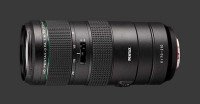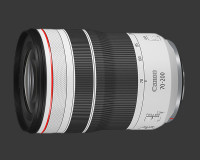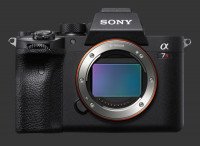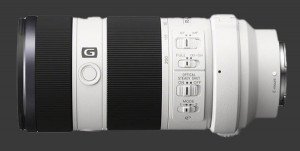Sony FE 70-200mm F/4G Review
Sony FE 70-200mm F/4G
The first telephoto zoom with Full-Frame coverage for E-mount is the Sony FE 70-200mm F/4G OSS. While a mirrorless platform is highly advantageous when designing short to medium lenses, the difference becomes minimal for telephoto lenses which have a much longer focal-length than the flange distance of a DSLR anyway.

The Sony FE 70-200mm F/4G OSS offers a classic medium telephoto zoom range with a constant F/4 maximum aperture. This type of lens provides telephoto reach with less bulk than typical F/2.8 lenses. This one stop difference can be taken back by increasing ISO one stop or improvements in image-stabilization when capturing static subjects. Even though most Sony Full-Frame Mirrorless have IBIS, the FE 70-200mm has its own image-stabilization mechanism with a standard and a panning mode.
This telephoto features completely internal zoom and focus mechanism. A fast focus motor inside the lens can focus down to 1.5m which reproduces subjects at 0.13X magnification. This is the lowest of any such lens which makes it unsuitable for close up photography.
Spanning 70-200mm while retaining a moderate aperture makes this lens well-suited for street photography. Outdoor action such as racing and sports are also great subjects for the FE 70-200mm F/4G. Travel photographers definitely will struggle with this lens due to its 840g weight. This is a very typical weight, even for similar lenses SLR lenses such as the Pentax HD D FA 70-210mm F/4 SDM WR
Pentax HD D FA 70-210mm F/4 SDM WR. Only the recently-launched Canon RF 70-200mm F/4L IS USM
Canon RF 70-200mm F/4L IS USM for Canon RF mirrorless is appreciably smaller and 20% lighter.
Given that this lens is relatively heavy, Sony provides a detachable lens foot so that it can be mounted directly on a tripod. The main benefit though is that it can rotate to keep the lens well-supported even while shooting in portrait-orientation. This model includes a focus-limiter switch and a customizable button in triplicate.

Construction
The shape of the FE 70-200mm F/4G is classic for constant-aperture telephoto zoom lenses. The body is made of a single piece that narrows down twice until it lines up with the width of the Sony E-mount. The widest part of the barrel is 8cm across. A short edge between the medium and small parts of the barrel prevents the collar of the optional tripod mount from slipping.
There are for 2-position sliders on the left-side of the lens barrel:
- AF/MF: Switches between AF and MF mode. If the camera is set to DMF mode, then manual focusing is possible in AF mode after focus has locked. MF mode always enables the fly-by-wire focus-ring.
- Focus Limiter: Selects between the full focusing range or from 3m to infinity. This improves AF speed by not considering subjects closer than 3m as AF targets.
- Stabilization: Toggle image-stabilization which is coupled with the camera body. When ON, it forces IBIS, when available. When OFF, it disables it. This unfortunately makes things confusing when swapping lenses.
- Mode: This poorly labelled switch selects standard image-stabilization in Mode 1 and panning in Mode 2.
All these switches have a nice detent and feel much more sturdy than those on the FE 24-105mm F/4G OSS.

An extra wide rubberized zoom ring is located around the middle of the lens barrel. It zooms from 70 to 200mm by rotating 90° clockwise. The rotation is smooth with just the right amount of resistance. Ahead of the zoom ring, a customizable button appears in triplicate on 3 sides of the lens. This button activates a function selected in-camera and is replicated for across in various lens-holding positions.
A fairly wide rubberized fly-by-wire focus-ring at the front of the lens turns extremely smoothly without stops. It only focuses the lens in MF or DMF mode. In all other focus modes, the focus-ring is simply ignored.
The front of the Sony FE 70-200mm F/4G OSS is threaded to accept 72mm filters. A bayonet mount accepts a deep cylindrical lens hood which comes with the lens. The body of the lens and hood are covered in white-paint which is said to reflect light to prevent the lens from overheating. With its 17.5cm length and white color, this lens is easy to notice. This lens is weatherproof and very solid..
Sony FE 70-200mm F/4G OSS Sharpness
Telephoto lenses are conceptually easy to design since they need simpler optics and capture rays with a small difference in incidence angle. The main difficultly is in shrinking down optics while maintaining performance.
Sharpness of the Sony FE 70-200mm F/4G OSS is much more variable than expected. Towards the wider-end, central sharpness is really good wide-open. Just half-a-stop down at F/4.5, details are completely crisp. Corners though are very soft from F/4 down to F/8 and only become slightly soft at F/9.5. Peak performance for corners at 70mm happens at F/13-F/16 right when diffraction starts.
Near the middle of the zoom, central sharpness good yet never completely crisp regardless of aperture. There is a slight improvement from F/5.6. Details are corners are very soft wide-open, gradually improvement towards acceptable at F/6.7. At 100mm, the FE 70-200mm F/4G becomes sharp at F/9.5 and renders completely sharp details at F/11. Performance changes yet again at the long end. The center of images is a little soft at F/4 but quickly improves with F/5.6 being good and F/6.7 being great. Corners are very soft wide-open and stay that way until stopped down quite a bit.
Our unit may a misaligned element since the left side gets sharper around the middle of the zoom, while the right side becomes sharper towards the long end. At 200mm, the right side appears reasonable sharp at F/5.6 but the left stayed blurry even stopped down to F/16.
Note that sharpness is perceived differently according to display size and since this analysis was performed on the 61 MP Sony Alpha A7R IV
Sony Alpha A7R IV at 180 DPI, it corresponds to a 45" x 30" print. The softness measured will be lower on a camera with fewer megapixels.
Shown below are 5 crops taken from a photograph, repeatedly captured for each combination of focal-length and aperture. Smaller pieces are cropped from extreme corners of the images, while the middle wide crop is taken from the center of images. Select an aperture in a row for a desired focal-length to see the crops from the corresponding image. When judging image quality, understand that these are crops from a 61 MP image which is normally used to print images up to 45x30". On a computer display, these may appear much larger which magnifies image defects.
Performance
Although the sharpness of this lens did not meet expectations, other optical qualities of the FE 70-200mm F/4G are nearly impeccable. Distortion is absolutely minimal at all focal-length and would only be noticeable in straight lines crossing most of the frame.
There are no signs of chromatic aberrations at any combination of focal-length and aperture. The lens is equally resistant to flare and maintains contrast very well even in the presence of bright light sources. Vignetting is a little high wide-open but improves rapidly as the lens is stopped down. At F/4.5, vignetting is around 1 EV which is noticeable in photos with a uniform background. By F/5.6 though, vignetting is minimal.
Autofocus performance of this lens is solid yet not up to modern standards. This model is 6 years old after all and there was plenty of advances in autofocus technology since then. The good to moderate light, the lens focuses quite rapidly, in under ¼s usually. When light levels drop, this extends to around ½s. The AF system is decisive though and nearly silent.
Conclusion
This lens delivers a good middle-ground performance. Its optics are no match for the Sony FE 70-200mm F/2.8 GM OSS
Sony FE 70-200mm F/2.8 GM OSS but that lens is 75% heavier and 50% more expensive. Most other telephoto zooms for E-mount are rather dim with poor optics and slow AF performance due to narrow maximum apertures. This leaves the Sony FE 70-200mm F/4G OSS in its out segment.
Overall, the FE 70-200mm F/4G delivers a balanced performance. Central sharpness is good throughout and even great at some combinations of focal-length and aperture. Corners are definitely soft but they do get sharper in the wider two-thirds of the focal-range. When F/6.7 or F/8 is suitable, this lens produces good results. Plus, distortion, chromatic aberrations and flare are never an issue. Vignetting nearly goes away one stop down which is required anyway for obtaining reasonable corner sharpness.
The autofocus system in this lens is quick and decisive when F/4 is used. It is also impressively quiet. There is also image-stabilization for those with older cameras. All together, this is a reasonable lens for these with limited space or budget.

Please Support Neocamera
All information on Neocamera is provided free of charge yet running this website is a huge endeavor. Purchases made via affiliate links found throughout the site help keep it running and up-to-date. There is no additional cost to you, so please consider buying via these links to our affilates:
If you found any information on this site valuable and did not purchase via our affiliate links, please considering donating via PayPal:
Any amount will be greatly appreaciated. Thank you for your support!
Sony FE 70-200mm F/2.8GM
For their professional telephoto zoom lens, Sony introduced the lighter F/4G version first. Two years, later the a premium G-Master version with bright F/2.8 maximum aperture launched.

The Sony FE 70-200mm F/2.8 GM OSS covers exactly the same focal-range as the FE 70-200mm F/4G except it aperture is a full-stop brighter. Both lenses are fully weatherproof and include image-stabilization but the F/2.8 GM provides another level of optical performance.
A more effective image-stabilization, which makes a difference on older unstabilized mirrorless cameras, is included in the FE 70-200mm F/2.8 GM. The more complex optical formulation of this lens allows it to focus down to 96cm for a maximum magnification of 0.25X, twice as much as the F/4G. An 11-blade iris renders smoother bokeh too.
All these improvements come with exactly two expected consequences: The Sony FE 70-200mm F/2.8 GM OSS weights 1.5kg, making it the heaviest lens in its class. It also sells for 50% more with a retail price of $2000 USD, compared to $1400 USD for the F/2.8 GM and F/4G respectively.
Updates
2025.01.18

Fujifilm GFX 2025 Lens Roundup
Lens Review roundup of Fujifilm GFX Medium-Format lenses. Quality, performance and handling of the GF20-35mm F/4R WR, GF30mm F/3.5 Tilt-Shift and the GF55mm F/1.7.
2024.11.18

Best 2024 Photography Gifts for Every Budget
Great gifts for photographers and photo enthusiasts selected for every budget among the best products of 2024.
2024.08.07

Eye Protection Tips for Professional Photographers
The four main considerations for professional photographers regarding eyewear.
2024.07.14

Fujifilm X100VI Review
Flagship fixed-lens compact digital camera with a 40 MP sensor and Image-Stabilization, a first for the series. Retro design featuring dual control-dials, plus direct ISO, Shutter-Speed and EC dials. Its hybrid viewfinder can switch between EVF and OVF mode.
2024.05.09

Fujifilm GFX100 II Review
Flagship 102 Megapixels Medium-Format Mirrorless Digital Camera with 8-Stop 5-Axis IBIS, 8 FPS Drive, 8K Video and 400 MP Super-Resolution capture in a weatherproof and freezeproof body with dual control-dials and dual memory-card slots.
2024.04.03

Fujifilm X-T5 Review
Newest Fujifilm flagship boasting a 40 MP APS-C sensor, 5-axis IBIS with 7-stop efficiency, 15 FPS continuous drive, 6.2K Video capture, dual control-dials and dual SDXC UHS-II slots in a sturdy weatherproof and freezeproof body.
2023.11.20

Best Digital Cameras of 2023
Find out which are the Best Digital Cameras of 2023. All the new Mirrorless Digital Cameras from entry-level to high-end professional.
2023.07.10

Fujifilm X-H2 Review
40 Megapixels APS-C Hybrid Mirrorless Digital Camera with 7-stop IBIS. Fastest shutter ever and 8K video capture. Large builtin EVF with 0.8X magnification and 5.8 MP, plus an Eye-Start Sensor. Packed with features and large number of controls in a weatherproof and freezeproof body.
2023.05.07

Sony FE 20-70mm F/4G Review
Review of the unique Sony FE 20-70mm F/4G lens. The optical zoom of this lens spans ultra-wide-angle and medium focal-length coverage, making it one of the most versatile Full-Frame lenses on the market.
2023.01.15

Huion Inspiroy Dial 2 Review
Review of the Huion Inspiroy Dial 2 tablet, a medium sized drawing surface with dual dials and customizable buttons. Connects via USB-C or Bluetooth 5.0 with Windows, Linux and Android support.
2022.12.08

How to Pack for a Photo Trip
Find out how to pack for a travel photography trip, carry your gear safely while meeting airline regulations.
2022.11.13

Best Digital Cameras of 2022
The best digital cameras of 2022. A short list of the most outstanding models in their respective categories. Choose one for yourself or as a gift.
2025.01.18
2024.11.18
2024.08.07
2024.07.14
2024.05.09
2024.04.03
2023.11.20
2023.07.10
2023.05.07
2023.01.15
2022.12.08
2022.11.13
NEWS
2025.03.26

Canon Launches Pair of Cameras and Lenses
Digital Camera ○ Lens
2025.03.25

Venus Optics Launches Vista Vision Cine Lenses
Lens
2025.03.24

Think Tank Photo Walker Pro
Bag
2025.03.20

Fujifilm First Fixed Lens Medium-Format Camera
Digital Camera
2025.02.26

Sony Launches Two New Lenses at CP+2025
Lens
2025.02.25

CP+2025 Showcases Numerous Launches
Digital Camera ○ Lens
2025.02.13

Nikon Launches 5X Full-Frame Power-Zoom Lens
Lens
2025.02.05

Nikon Refreshes Flagship Ultra-Zoom
Digital Camera
2025.02.05

Nikon Launches Ultra-Bright 35mm F/1.2 Prime Lens
Lens
2025.01.21

Fujifilm Evolves INSTAX Wide
Digital Camera
2025.01.16

Leica Launches SL3-S
Digital Camera
2025.01.14

Think Tank Photo Launches Dark Light Tactical Backpacks
Bag




















